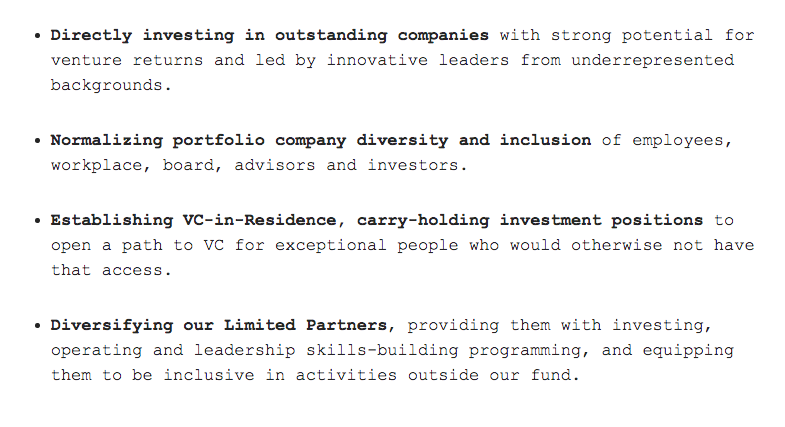Moving the diversity needle in the startup space requires a multifaceted approach. The importance of investing in women and other traditionally underrepresented founders simply can’t be overstated – as my Founding Partner at the W Fund, Allyson Kapin (also CEO & Founder of Women Who Tech), urgently put it this morning (“Why The Next Jeff Bezos Won’t Be a White Man“).
But that’s not enough.
One of the things we’ve always said at Women 2.0 (and the literal reason that we’re structured the way we are) is that we can do all the work we want with women and underrepresented founders, but if we aren’t changing the other side of the table – the side that dictates the flow of money, the populations served by products, and the success of founders – any potential impact will be lost.
We’ve seen what happens when you only address one side of it first hand (that’s an entirely separate article, possibly a small novella), and it’s crucial to tackle both.
This is the same exact approach that’s been applied to the W Fund.
What are all the areas within this fund – beyond our thesis – that we can use to change the entire face of VC?
We’ve got a lot more coming down the pipeline in this regard, but here are the first four we know we can execute on immediately while we continue to fundraise, expand our team, and get key operating budget to role out additional programming. I’ll address the VCIR in more detail below, we’re excited about that one.

We do not have all the answers, but we wake up every day and think and talk to others about these types of things when we’re moving forward. (And also, we’ll take all the feedback and new ideas we can get on how to make this better!)
Today’s cold, hard reality.
When 86%+ of the people who write out cheques to startups (a.k.a. decide on the entire future of innovation) look and think a certain way, we end up with 2.7% or less of that funding going to people who don’t look like those cheque writers (Again, Allyson lays out a lot of the stats around founders in her piece).
Right now, these are some of the current stats in VC in regards to diversity:
- Ethnically homogenous partners see 26-32% lower fund performance.
- In 2018, only 9.65% of decision-makers at US VC firms were women. This went up to 13% as of February of this year.
- The number of VC firms with two or more women partners doubled from 2018 to 2019, but still sits at 14%. Only one of the women who became partner in 2019 was a black woman. 65% of VC firms still do not have a single woman Partner.
- VC firms that scored a top-quartile fund between 2009 and 2018, 69.2% of them had women in decision-making roles.
- Fewer than 1.3% of the $96.1T in global assets are being managed by people of color or women. Did you know they’re viewed less favorably by investors than similarly accomplished white-led firms? (That’s not logical!).
There are more stats that point to the fact that, while adding diversity to your investment teams seems to make you more successful, the representation numbers don’t line up.
More recently, as you can imagine, the heated social conversations around racial justice across the country have quickly made their way into the startup space, and have resulted in waves of VC firm commitments to both diversify their investments and their teams. Many have called these moves out as ‘diversity theater‘.
These numbers – and mindsets – aren’t moving.
But at the risk of turning this into a vent, I wanted to share several collective thoughts around how VC firms – and specifically their Partners, GPs and Leadership – can rethink their own impact on the diversity of the VC industry at large.
Rethink and restructure
Boy (pun intended) have VC firms functioned just about the same way for decades, huh? It’s time to shake things up, think outside the box.
A few of the ways the current structure is inhibiting:
- Looooooong track to Partnership. Loooooooong track to decision-making. Looooooooooooong track to carry. (Those are a lot of Os people!!)
- “Requirements”, even of Associates, sometimes automatically bar a lot of great talent. (like, really, who needs an MBA? And this is coming from someone who’s over-degreed herself. You don’t need it!)
- The wave of bringing in successful operators is cool thinking…. but when 2.7% or less of funding goes to women founders (0.2% to Black women, 0.4% to Latinas…. etc etc), or just over 100 black women founders have even raised over $1M, you’re creating yet another pool of “new VC talent” that isn’t actually that diverse. (I hope y’all are seeing what a self-fulfilling prophecy this is by now).
- Personal GP commitments at most funds are so prohibitive, you need to be ultra successful to take part at that level. (Does your dollar level of “skin in the game” need to be someone else’s dollar level of “skin in the game” to get the same motivational results? Isn’t this all relative?)
I’ll stop there, but this is an opportunity to reassess your firm’s structures and processes to figure out how you can do better. It does require change.
One of the things we’re proud of at our fund is the VC-in-Residence program we’ve set up. We asked ourselves how close to our central fund processes and decision-making we could possibly bring someone who has an awesome background, but absolutely no investing experience.
What we came up with was a 12-month VCIR program that can be done part time (paid) and that is also carry-holding (we consider this ridiculously important!). In that way, we allow them undeniable exposure to and direct experience in venture capital.
If they stay with us and grow, amazing. But if they leave us after their 12 months and enter a VC firm at a higher level than they would have otherwise, we have Done. Our. Jobs. (PS: We have two awesome Founding VCIRs who’ve been with us for a bit as we launch).
If you’re interested in learning more about the W Fund, feel free to email us [email protected].
Think about your fund Advisors also (all of whom we expect are getting a piece of the carry). Can you potentially use those roles to do part of this work?
If you have a Scout program that intentionally includes women or people from other underrepresented groups (if you have a Scout program that doesn’t include these profiles… well… you’ve got some more work to do), consider strongly if you’re fully supporting their own path in a meaningful way, or if you’re not.
Rodney Sampson, Executive Chairman & CEO, Opportunity Hub, has highlighted several specific ways you can think about your Scout program. I suggest you check it out.
One of the items Rodney calls out, which we agree is one of the crucial pieces to rethink, is incentive structures. Have you made sure that everyone in your firm, in your deal process, in your advisory roles are all paid equitably in terms of salary, equity, benefits, perks and carry? At the end of the day, as he states, a VC firm is only as successful as the companies it invests in. If there are people involved in your fund who are even marginally responsible for that success, they should likewise realize the upside.
Work harder for great investment talent
It no longer works to rely on your network and personal introductions to fill investment roles if you want to expand the diversity of your team. Actually, it never worked (Total sidenote (not really), but have you checked your social networks lately?). That’s why we’re looking at the demographic numbers as they are today. There’s too much homogenous thinking.
But if you’re committed to finding diverse investment talent, it really does take work. Sorry, not sorry.
To use an analogy, one of the most bothersome things we’ve seen in the past few years specifically with “committed” firms who would like to “increase the diversity” of either their hiring pipeline or their founder pipeline is that their actions are quick, surface level, and don’t carry long-term impact.
For instance, it’s not enough to simply post your accelerator program in a newsletter for women founders and have your job be done.
The same goes for building out your investment team. It requires real work. It requires building relationships, showing up more, and being aware of your own actions during the process.
Another idea? Your basic standard mentorship! With a splash of sponsorship as well (a really big splash). I don’t think I need to explain this, but just go out and do it. NOW. Do it within your own firm, or do it outside your firm. In either case, this is a personal move you can make that will have a positive impact on the career pathway of a future Partner.
Yet another idea? Office hours for emerging fund managers!
Invest in and co-invest with emerging fund managers
On the note of relationship building and using your privilege as an established firm, you could have your entire firm mentor/sponsor an emerging fund manager. Who of us wouldn’t sign up for this?
Pushing you further, consider making a fund investment in that manager (and don’t try to wave the management fees, that’s like telling someone you want the upside but don’t want to pay them).
But only do this if you realize that this is a huge win win! While working with an individual investor as they grow, you’ll also being creating a relationship that could benefit you in terms of deal flow, co-investment opportunities and possible future investment talent for your fund.
Again, this is a win win. This talent brings a lot to the table….
Fund programs can be leveraged too. Yesterday, Techcrunch published insights from Lo Toney around updating VC (“Lo Toney has some ideas about how to (really) bring VC into the 21st century“). Toney shares legitimate concerns about the representation of VC, especially at the Partner level.
But he’s trying to do something about it, in a way that may not necessarily directly impact his firm. A forthcoming program from his fund, Plexo, will, in part, “institutionalize the work that Plexo already does in an ad hoc way around helping managers to prepare marketing materials, pitch their strategy to both high-net-worth individuals and institutions and manage LP communications after that base of investors has been established.”
This morning, Techcrunch (H/T Techcrunch) highlighted the current thought process behind billionaire Chris Sacca’s investments in the startup space, which he now primarily does by investing in fund managers. Chris is “particularly keen on backing people of color and women because they have both networks and an understanding about particular products that many established VCs of the white, male variety do not.”
Said Sacca, when you “cut through barriers that have prevented women and other underrepresented groups from telling their stories, you find exceedingly talented, ambitious, driven people who, given the chance to succeed, are kicking ass.”
Sacca is literally putting millions and millions of dollars where his mouth is. (PS: ✋ ✋ ✋ Chris!)
Show up and put your money where your mouth is.
My first call to action for all “traditional” decision-making partners is to get out more. Sounds fun? It is, we have a ton of fun.
Show up at events where future diverse Partners might be, don’t just send your woman or non-white Partner (if you have one).
Send yourself. Make yourself uncomfortable, I promise most of us absolutely love having you there. (And also do this for any founder-focused event!!).
I can’t stress how important this is, even from a basic signaling standpoint. When we see you there, it means something. When we don’t, that also means something. It’s a rarity that I see white male VCs attend an event for “us” unless they’re a speaker.
Can I share some more insider info with you? Since I’ve been on board (2016), Women 2.0 has never once received sponsorship dollars from a VC firm. I worked at a similarly-focused non-profit for about 8 years prior to that….same deal. They have never once written out a cheque in support of the programming we do that ultimately provides them with deal flow, or networking and exposure, or other benefits.
But enough about us. What about the others? Unfortunately, we’ve heard many of the same reports from sister and brother organizations who work – often tirelessly – to do exactly what this entire article is focused on.
VC firms should truly think about investing in the community organizations tackling these issues.
When you don’t, it puts community leaders in a very difficult spot. We know the work we do must go on, we must serve and involve VC firms (and, as a result, the VC firms will benefit), but it’s sometimes incredibly painful to have those efforts scooped up so readily with no give back.
All of the community organizations you work with wake up (and have woken up) every day to make these changes. I cannot stress strongly enough how important these organizations are to the ecosystem in which you live, work, breath…..and make money. Stop trying to recreate wheels inside your own firm and reach out and pull in the folks who really know what they’re doing.
Several of the ones we love who are doing work on this side of the table (also not an exhaustive list!):
- Impact Capital Managers
- Diversity.VC (heads up, their Future VC program is coming to the states)
- BLCK VC
- Pipeline Angels
- All Raise
- NYC Blend
Check your own level of Allyship and Advocacy
Super quick end note.
Unconscious biases play a major role in decisions made about the selection and hiring process in any organization, and VC firms is no exception. I won’t spend too much time here, but one big, huge key to all of this is take a look at your own level of self- and situational awareness about how you interact with the people and systems around you.
How often have you and do you think about your role as VC firm or Partner in diversifying VC? Are you positively, neutrally, or negatively impacting an inclusive startup ecosystem through all of your firm’s actions? Can you do better? Can your team do better?
Do you believe in this, truly, and how will you take action??
What are you going to do starting today to change this?

